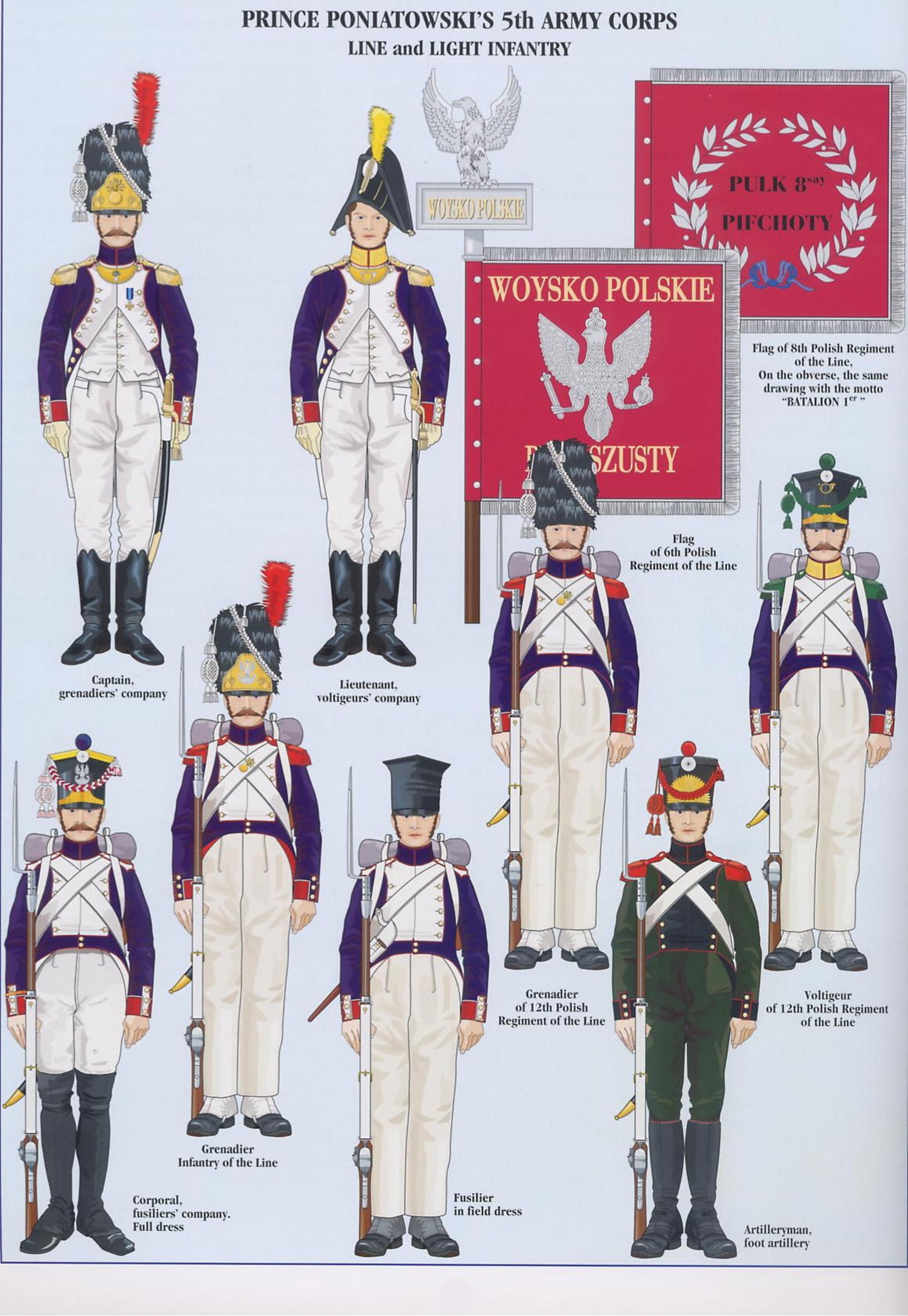
Following the victories at Austerlitz (1805) and later Jena
and Auerstädt (1806), Napoleon called on Poles to establish a “Northern
Legion” (also known as the Vistula Legion and, originally, the Légion
Polacco-Italienne of the newly created Westphalian Army), yet without
mentioning “Poland” in the name of the unit. In December 1806 three
divisions numbering more than 13,000 troops were ready. They were formed in the
former Polish territories annexed following Napoleon’s recent victories against
Prussia and equipped with Prussian arms manufactured in Potsdam. These
divisions, reorganized and enlarged in the following months, took part in the
campaigns against the Russians and Prussians in East Prussia in 1806-1807. In
so doing they played their part in the victory at Friedland (14 June 1807),
which led to the Peace of Tilsit (7 July) and to the establishment of the Duchy
of Warsaw.
The Duchy of Warsaw was a weak state, yet Polish politicians
and officers made a huge effort to organize a sizable army to support it. This
was not easy, considering the limited finances of the duchy. Nevertheless an
attempt was made to organize a force about 30,000 strong. Part of these
forces-the Polish Division and the Polish-Italian Legion-were financed by
Napoleon himself, who sent the former formation to serve in Spain in 1809.
In April of the same year hostilities broke out yet again
between France and Austria in what became known as the War of the Fifth
Coalition. Notwithstanding that the troops of the Duchy of Warsaw present on
home soil numbered just 15,500, they were made responsible for the task of
tying down in battle more than 30,000 Austrians under Archduke Ferdinand. At
Raszyn on 19 April Polish forces tried to halt an Austrian advance toward
Warsaw. The Poles managed to slow the enemy’s progress but they failed to
prevent the Austrians from entering Warsaw. Polish forces (about 11,000) then
undertook a new operation on the right bank of the river Vistula, capturing
Lwow and Krakow. Even with these successes the position of Polish forces
remained weak, and an armistice reached on 12 July was welcomed.
Napoleon’s victory over the Austrians in the campaign of
1809 left the territory of the Duchy of Warsaw considerably enlarged. At the
same time, the army was increased to more than 60,000 men, consisting of 42,000
infantry and 12,800 cavalry, artillery, and technical troops. Approximately
52,000 troops were based in the duchy itself, with another 10,000 elsewhere, of
whom 8,000 were serving in Spain.
In January 1812 Napoleon issued an order to prepare the
Grande Armée for operations against Russia. The Polish contingent constituted
about 20 percent of the halfmillion-strong army. On top of this the Duchy of
Warsaw had to cope with the impossible logistical task of coordinating the
army’s supplies once it passed over the border into Russia.
One Polish corps (V Corps) was organized within the Grande
Armée under the command of General Jozef Poniatowski. His corps comprised the
16th Infantry Division (two infantry brigades, one cavalry brigade, and
artillery: 11,000 troops in total); the 17th Infantry Division (two infantry
brigades, a cavalry brigade, and artillery: 12,000); and the 18th Infantry
Division (two infantry brigades, one cavalry brigade, and artillery); plus
supplementary artillery units and technical-engineering units, comprising about
14,000 more troops. In all, at the outset of the Russian campaign, V Corps
numbered about 37,000 troops. Additional large Polish formations were
incorporated into Marshal Joachim Murat’s IV Corps, Marshal Jacques Macdonald’s
X Corps, and IX Corps, with smaller contingents in I, II, and III Corps. It is
estimated that at the beginning of the campaign Polish forces in the Grande
Armée numbered 74,700 troops, later to rise to 91,400 (including the National
Guard).
The campaign began on 22 June. Polish forces played a
prominent part in the operations, capturing Grodno, struggling to defeat the
Russians at Smolensk and Borodino, and occupying Moscow. From November 1812
Polish troops took part in the retreat of Napoleon’s army from Moscow. In
several cases Polish forces formed the rear guard of the retreating army.
Polish troops reached Vilnius in December 1812. Barely 15,000 men in the
allPolish formations and 3,000 of those in the Franco-Polish formations
survived. Thus, about 70,000 Polish soldiers of the army of the Duchy of Warsaw
were lost during the Russian campaign.
In spite of these catastrophic losses, Poniatowski undertook
yet another attempt to organize a new army of the Duchy of Warsaw. In February
1813 he left Warsaw with about 6,000 men. This force was to reach 16,000 three
months later (while an additional 18,000 troops manned various fortresses in
the duchy), organized to form two infantry and two cavalry divisions, in all
constituting VIII Corps. On 17 May these troops left Krakow for Saxony. About
10,800 men took part in the Battle of Leipzig on 16-19 October. Poniatowski
drowned at the close of the battle as he attempted to cross the river Elster
with retreating troops. About 10,000 men from VIII Corps were either killed or
taken prisoner in the battle.
Several smaller units continued to take part in various
battles fought by Napoleon’s forces, even as late as Waterloo, yet the
100,000-man army of the Duchy of Warsaw was lost. As the Russians advanced west
in 1813 the duchy’s fortresses successively fell to their troops. The future of
Poland and the Poles was to be decided at the Congress of Vienna.